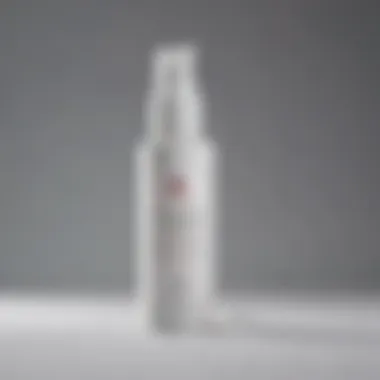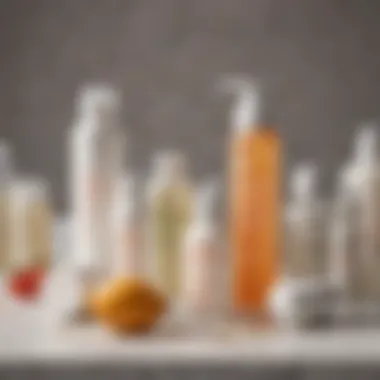Best Acne Drying Lotions: Your Ultimate Guide


Intro
Acne presents a challenge that many face at various stages of life. For some, it is a fleeting issue, while for others, it becomes a persistent problem that can affect confidence and well-being. This article delves into the world of acne drying lotions, focusing on their ingredients, effectiveness, and how to choose the right product for your skin type. A targeted approach can lead to clearer skin. However, understanding how environmental factors and lifestyle choices may contribute to acne is equally essential.
Trending Topics
Recent developments in the beauty industry highlight the increasing demand for effective skincare solutions. Specifically, acne drying lotions have gained popularity for their targeted action against blemishes.
Innovations in Acne Treatment
The market now showcases innovative ingredients in acne drying lotions. Ingredients like salicylic acid, benzoyl peroxide, and sulfur provide effective results. Salicylic acid penetrates the pores and helps exfoliate, while benzoyl peroxide fights bacteria. With the rise of clean beauty, many brands now prioritize using natural ingredients for those seeking gentler options. Products like Mario Badescu Drying Lotion leverage these trends, offering high efficacy with a more holistic approach.
Understanding Skin Types
Not all skin types react the same way to acne treatments. While oily skin may tolerate stronger formulations, sensitive or dry skin necessitates milder products. Knowing your skin type is crucial when choosing an acne drying lotion. Many consumers have found success by reading product labels carefully and choosing what complements their unique needs.
Step-by-Step Guides
The process of selecting the right drying lotion can be straightforward if approached step by step.
Determine Your Skin Type
- Oily Skin: Look for products with higher concentrations of salicylic acid or benzoyl peroxide.
- Dry/Sensitive Skin: Options containing calming ingredients like chamomile or aloe vera might suit better.
- Combination Skin: You may need to use different products on various areas of the face.
Product Selection
- Read reviews to understand others’ experiences.
- Check for endorsements from dermatologists or skin care experts.
- Consider fragrance-free or hypoallergenic options if you have sensitive skin.
Product Reviews
While various products are available, some have gained prominence for their effectiveness.
In-Depth Analysis of Popular Items
Mario Badescu Drying Lotion: This product has received acclaim for its dual action. It targets pimples while preventing new ones from forming. The distinct pink liquid indicates its potent formula, which includes salicylic acid and calamine.
Clinique Acne Solutions Liquid Facial Soap: Not a drying lotion but complements drying lotions well. It helps prevent future breakouts while maintaining skin balance.
"Choosing an effective curing lotion requires more than just picking a popular brand. It’s crucial to know what works for your skin type."
Comparative Reviews
When comparing drying lotions, consider factors such as:
- Ingredient effectiveness
- User reviews
- Price point
Using this information can guide your decision, ensuring you invest in products that align with your needs and values.
Prelims to Acne Drying Lotions
Acne affects many individuals, and its management is a crucial concern. The use of acne drying lotions provides one of the solutions available today. Understanding how these lotions work, their ingredients, and the target audience can empower people to make informed decisions. An effective acne drying lotion can significantly reduce the appearance of blemishes, help prevent future outbreaks, and provide lasting relief from discomfort associated with acne.
When we talk about acne drying lotions, it is essential to note that they are not a one-size-fits-all solution. Each individual's skin type and acne condition require attention to choose the right product. This article will detail the different components of these lotions, emphasizing the importance of recognizing their role in a broader skincare routine. Additionally, we will dive deeper into how lifestyle choices also play a significant part in acne management, making it clear that lotions alone may not be sufficient.
Moreover, the right acne drying lotion can lead to reduced irritation, minimized breakouts, and overall improvements in skin health. Ultimately, consumers should be considering how these products can fit into their daily lives and aid their journey to clearer skin.
Understanding Acne


Acne is a common skin condition, particularly among teenagers and young adults. It can also persist into adulthood, causing not only physical but emotional challenges as well. Acne typically appears as pimples or cysts on the face, back, and shoulders. Understanding the causes of acne, including hormonal changes, genetics, and lifestyle factors, can help individuals better manage this condition.
The formation of acne occurs when hair follicles become clogged with oil and dead skin cells. Bacteria may also play a role, contributing to inflamed spots. Recognizing the different types of acne — such as whiteheads, blackheads, and cystic acne — is fundamental for effective treatment. This knowledge can steer individuals towards suitable products, including drying lotions. These targeted treatments can be a necessary response to acute breakouts or an effective strategy for ongoing care.
What Are Drying Lotions?
Drying lotions are topical remedies specifically formulated to treat acne. These products typically contain a mix of active ingredients designed to absorb excess oil, reduce inflammation, and speed up the healing process. They are generally used as spot treatments, applied directly to affected areas. The application of a drying lotion can help reduce the size and redness of blemishes overnight, offering both immediate relief and long-term benefits.
Most drying lotions are designed to be simple to use. After cleansing the skin, users apply a small amount of the lotion onto the blemish, avoiding larger areas of healthy skin. Many people find that using these products as part of their skincare routine leads to a reduction in acne over time. Understanding the mechanics behind these lotions can enhance their effectiveness, making them a critical element in the quest for clearer skin.
Key Ingredients in Acne Drying Lotions
Understanding the ingredients in acne drying lotions is crucial for making informed skincare choices. The efficacy of these products largely stems from their active components. Knowing what each ingredient does can greatly enhance the chances of successfully managing breakouts.
Salicylic Acid
Salicylic acid is a beta hydroxy acid (BHA) widely recognized for its ability to penetrate the pores. Its primary function is to exfoliate the skin, removing dead skin cells that can contribute to acne. This ingredient also has anti-inflammatory properties, helping to reduce redness and swelling associated with outbreaks. For many, salicylic acid’s ability to breakdown oil and prevent clogged pores makes it a go-to solution. However, it’s important to start with a lower concentration to assess skin tolerance, as excessive use can lead to dryness.
Benzoyl Peroxide
Benzoyl peroxide is another powerful ingredient often included in acne treatments. It works primarily by killing the bacteria that cause acne, reducing the likelihood of breakouts. This ingredient releases oxygen into the pores, which is fatal for the anaerobic bacteria responsible for acne. While effective, benzoyl peroxide can sometimes cause skin irritation and peeling. Therefore, those with sensitive skin should consider patch testing beforehand. In the pursuit of clear skin, it may also be beneficial to alternate benzoyl peroxide with other treatments to minimize irritation.
Zinc Oxide
Zinc oxide serves multiple purposes in acne drying lotions. It has antibacterial properties that help control acne-causing bacteria while also providing a soothing effect on inflamed skin. Furthermore, zinc oxide aids in the healing process of blemishes and can also act as a physical sunblock. This makes it a popular choice for formulations targeting both active acne and post-acne marks. Since it is generally well tolerated, it is suitable for a variety of skin types, including sensitive skin.
Sulfur
Sulfur is often overlooked but is an effective ingredient in acne treatments. It has antimicrobial properties and effectively absorbs excess oil, which makes it particularly useful for those with oily skin. Additionally, sulfur promotes the shedding of dead skin cells, helping to unclog pores and facilitate healing. Although it may have a distinct smell, its effectiveness in calming breakouts cannot be dismissed. Users should be aware, though, that sulfur can cause dryness and should be used thoughtfully, particularly in conjunction with moisturizers.
Evaluating the Best Acne Drying Lotions
The process of evaluating acne drying lotions is fundamentally essential in this comprehensive guide. A plethora of products exists in the market, each claiming to resolve acne issues effectively. Thus, distinguishing between various formulations becomes necessary. The evaluation must cover specific elements that contribute to the effectiveness of these products. These include active ingredients, the target demographic, user feedback, and price considerations.
Understanding the benefits of each product is crucial for informed decision-making. Customers must contemplate their individual skin types and specific needs when selecting a drying lotion. For instance, someone with sensitive skin will require different characteristics compared to someone with oily skin.
By carefully evaluating these products, consumers can enhance their chances of selecting a product that not only targets their acne effectively but also aligns with their entire skincare routine. A well-informed choice can lead to better skin clarity and confidence.
Top Products Reviewed
When diving into the top acne drying lotions, it's essential to discuss the most promising products in the market today. This review will cover the features and benefits of each product, providing valuable insights for discerning consumers.
Product One: Features and Benefits
Product One: Mario Badescu Drying Lotion
Mario Badescu Drying Lotion stands out in the market for its effective formula. This lotion is praised for its dual-action, combining salicylic acid with calamine. This balance reduces inflammation and promotes faster healing of existing acne.
One of the key characteristics of Mario Badescu's product is its simplicity in application. The unique feature is its two-layer solution; it requires gently dipping a cotton swab into the bottle, allowing only the pink sediment to touch the skin. This method limits excess contact, reducing irritation potential while targeting blemishes. An advantage of this product is its rapid results. Users often report noticeable improvements within days. However, it is essential to note that some may experience dryness surrounding treated areas, thus proper hydration post-treatment is recommended.
Product Two: Features and Benefits
Product Two: Clinique Acne Solutions Clinical Clearing Gel
The Clinique Acne Solutions Clinical Clearing Gel also merits discussion. This gel is effective and is renowned for incorporating benzoyl peroxide, which is adept at tackling various acne forms. Its lightweight formula absorbs quickly and does not leave a greasy residue.
Clinique's unique feature is its non-irritating formula. It is suitable for sensitive skin, which is a crucial consideration for many acne sufferers. The key characteristic here is the gel's ability to target not just visible acne but also provides preventive measures against future breakouts. Users often appreciate its fast absorption and the non-oily feel. However, the concentration may be too low for severe acne cases. In such instances, it could necessitate continuous use to see prolonged effects,
Product Three: Features and Benefits
Product Three: Proactiv MD Advanced Acne Treatment
Finally, Proactiv MD Advanced Acne Treatment deserves a place on this list. This product integrates various powerhouse ingredients, including adapalene, known for its effectiveness against stubborn acne.
The standout characteristic of Proactiv MD is its multi-faceted approach to acne treatment. It not only targets existing breakouts but also prevents future occurrences. Users note its effectiveness for moderate to severe acne, making it a popular choice for those struggling with persistent issues. One unique advantage is the incorporation of a built-in moisturizer, reducing the dryness typically associated with acne treatments. However, initial use can lead to increased sensitivity; hence, users should gradually introduce it into their routines.


How to Choose the Right Product
Choosing the right acne drying lotion requires thoughtful consideration of several factors. Each individual's skin type, severity of acne, and skin concerns must guide the decision.
- Consider Skin Type: Identify if your skin is oily, dry, sensitive, or combination. This helps determine appropriate product formulations.
- Ingredient Awareness: Research the active ingredients in each product. Salicylic acid may be more effective for some, while benzoyl peroxide works for others.
- Frequency of Use: Some products are designed for occasional use, while others may be suitable for daily application.
- Read Reviews: User feedback is invaluable; learning from others' experiences can guide you to the right choice.
- Consultation: If uncertain, consider consulting a dermatologist, especially for severe acne issues.
By closely evaluating these elements, individuals can select the most beneficial acne drying lotion tailored to their specific needs.
Application Techniques for Drying Lotions
Application techniques play a critical role in the effectiveness of acne drying lotions. Proper application ensures that the product not only targets blemishes directly but also maximizes its potency while minimizing potential irritation. Each technique influences how well the active ingredients will work and ultimately impacts the skin's response.
An effective application method is one of the simplest ways to enhance results. When done correctly, these techniques can expedite healing and reduce redness associated with breakouts. Additionally, understanding the frequency of use helps in forming a consistent routine. This is essential for individuals looking to manage their acne effectively.
Proper Application Methods
The method of applying drying lotion can greatly influence outcomes. Here are steps for optimal application:
- Cleanse Your Skin: Before applying any product, it’s vital to start with clean skin. Use a gentle cleanser suitable for your skin type to remove dirt and oils.
- Avoid Moisturizers: Do not apply moisturizer before the drying lotion, as it can inhibit the product’s absorption.
- Use a Cotton Swab: Dip a clean cotton swab directly into the drying lotion. Avoid shaking the bottle to keep the sediment intact at the bottom, as this is where active ingredients are concentrated.
- Dab, Don’t Rub: Apply the lotion directly onto the pimple with the cotton swab. Gently dab it without rubbing or massaging in. This method limits irritation and ensures concentrated treatment on the target area.
- Leave It On: After application, let it sit overnight. This allows the active ingredients to penetrate fully and work effectively.
Adherence to these application methods can significantly influence the product’s overall effectiveness in treating acne.
Frequency of Use
The frequency of applying acne drying lotions depends on both the product formulation and individual skin response. Generally, starting with a once-daily application is advisable, preferably at night. Here are some considerations:
- Monitor Skin Reaction: Assess how your skin responds to daily use. If no irritation occurs, you can consider using it twice a day, but do this with caution.
- Concentrate on Breakouts: Focus on applying the lotion only where needed. Using it on unaffected areas may lead to unnecessary dryness.
- Recharge as Needed: If a breakout worsens, increasing frequency may help. However, every new application should be monitored closely for any sign of irritation or sensitivity.
Key Insight: Overuse does not equate to quicker results. Finding a balance that aligns with your skin’s tolerance is essential for achieving desired outcomes without causing harm.
Understanding and employing proper application techniques, along with sensible frequency of use, can contribute significantly to managing acne effectively. Recognizing your skin's needs is a critical factor in selecting the most suitable approach for treatment.
The Role of Skincare Routine in Acne Management
A proper skincare routine is essential for effective acne management. It involves the consistent use of specific products designed to control excess oil, prevent breakouts, and promote healing. Within a well-structured routine, each step has distinct benefits that contribute to the overall health of the skin. Understanding how each component functions is crucial for anyone looking to achieve clearer skin.
Cleansers and Exfoliants
Cleansers play a vital role in acne treatment. They help remove impurities, makeup, and excess oil from the skin’s surface. Choosing the right cleanser is key; look for those that are gentle yet effective. For oily and acne-prone skin, foaming cleansers with salicylic acid can be particularly beneficial.
Exfoliation is another important step. By sloughing off dead skin cells, exfoliants prevent clogged pores that can lead to breakouts. Chemical exfoliants, such as those containing glycolic acid, can be more effective than physical scrubs. When used correctly, they help promote cell turnover and give skin a fresh appearance.
It is advisable to exfoliate no more than two to three times a week to avoid irritation. Over-exfoliating can lead to redness and further exacerbate acne issues. Finding a balance is essential.
Moisturizers and Sunscreens
Moisturizers are often misunderstood in acne management. Many people think that if they have oily skin, they should skip this step. However, applying a suitable moisturizer is crucial, as it helps to maintain the skin’s natural barrier. Look for non-comedogenic products, which do not clog pores. Gel-based moisturizers can hydrate without adding excess oil.
Sunscreens are equally important. Ultraviolet rays can cause skin damage and exacerbate acne post-inflammatory hyperpigmentation. Choose a broad-spectrum sunscreen with an SPF of at least 30. Formulations that are oil-free or specifically labeled for acne-prone skin can be beneficial.
In summary, a comprehensive skincare routine including effective cleansers, careful exfoliation, appropriate moisturizers, and reliable sunscreens plays a key role in managing acne. Each element works together to create a balanced environment for the skin, ultimately assisting in the reduction of breakouts.
Lifestyle Factors Influencing Acne
Acne often seems like an issue confined to the skin, but its roots may run deeper, impacting various aspects of an individual's life. This segment focuses on how lifestyle factors can significantly influence acne occurrences, providing a holistic view alongside the topical treatments we often rely on. By understanding the interplay between our habits and skin health, readers can make informed choices that contribute to clearer skin.
Diet and Nutrition


The food we consume plays a crucial role in skin health. Diets high in refined sugars and dairy products have been linked to inflammation and hormonal changes that can exacerbate acne. For instance, foods with sugar spike insulin levels, which can increase oil production in the skin. A balanced diet rich in whole foods, such as fruits, vegetables, lean proteins, and healthy fats, can promote better skin health.
Key nutrients to consider include:
- Zinc: Supports skin healing and reduces inflammation.
- Omega-3 Fatty Acids: Found in fish like salmon, can help regulate oil production and minimize redness.
- Antioxidants: Vitamins A, C, and E can protect skin from damage.
Stress Management
Stress is another significant factor influencing acne. When we are under pressure, the body produces cortisol, a hormone that can lead to increased oil production. This surge in oil can clog pores and trigger breakouts. Practices for managing stress are crucial.
Some effective strategies include:
- Mindfulness and meditation: Regular practice can decrease cortisol levels.
- Physical activity: Engaging in exercises like yoga or running can help relieve stress.
- Hobbies: Finding time for activities that bring joy can counteract stress effectively.
Actively managing stress levels can thus support not only mental well-being but also contribute to clearer skin.
Sleep Quality
Sleep is often overlooked in discussions about skin health, yet its impact is profound. Lack of sleep can disrupt hormonal balance, leading to increased stress and consequently acne. The body repairs and regenerates skin during deep sleep, making quality sleep essential for maintaining skin health.
To improve sleep quality, consider the following:
- Establish a routine: Go to bed and wake up at the same time every day.
- Create a restful environment: A dark, quiet room can enhance sleep quality.
- Limit screen time before bed: Reducing exposure to blue light can prepare your body for sleep.
In summary, prioritizing good sleep habits can enhance skin repair processes, helping to minimize the likelihood of breakouts.
Potential Side Effects of Drying Lotions
The use of drying lotions can offer significant benefits for acne management. However, it is vital to understand the potential side effects that may arise during their use. Addressing these concerns allows individuals to make informed choices regarding their skincare products. Knowing what to expect can help mitigate adverse reactions and guide users towards achieving healthy skin.
Irritation and Redness
One of the most common side effects of acne drying lotions is skin irritation. Ingredients like salicylic acid and benzoyl peroxide can cause initial discomfort, which includes redness, peeling, and dryness. These effects are often most noticeable in the early phases of use. Sensitive skin may react more severely to these active components.
To address irritation, users should start with a lower concentration of ingredients and gradually increase usage. This allows the skin to acclimate to the active substances without overwhelming it. Moisturizers can also aid in reducing redness and providing a soothing effect after application.
Long-Term Usage Concerns
Another issue associated with drying lotions is the concern surrounding long-term use. Prolonged application can lead to over-drying and damage the skin barrier. This condition can cause a cycle of irritation where the skin produces extra oil to compensate for the loss of moisture. Thus, users might notice an exacerbation of acne instead of improvement.
To prevent these issues, it is essential to routinely assess the skin's condition and consult with a dermatologist if problems persist. Users should consider rotating products or incorporating hydrating products during treatment cycles. This strategy can maintain effective acne management while preserving skin health.
Key Takeaway: While acne drying lotions can be effective, understanding their potential side effects ensures safe and beneficial use.
The End and Recommendations
In exploring the landscape of acne drying lotions, it becomes evident that choosing the right product should not be taken lightly. The relevance of this section lies in the necessity for a thoughtful approach to managing acne. The market offers a plethora of options, but understanding your specific needs is key. Not every drying lotion will work for every skin type, making it crucial to recognize the elements that influence efficacy.
Finding the right balance in treatment often means experimenting with different products. Each person's skin reacts differently to various active ingredients. Therefore, it is advisable to start with a patch test to gauge the response your skin has to a new product. Consideration of your skin type—whether oily, dry, or combination—will also guide your choices. Furthermore, it is wise to combine the use of drying lotions with a consistent skincare routine. This routine should include cleansing, exfoliating, and moisturizing, ensuring that your skin remains balanced and healthy.
Finding the Right Balance in Treatment
Finding balance is central to resolving acne effectively. This involves integrating your drying lotion into a broader skincare regimen. The best approach is often gradual. Start using the lotion in moderation. Observe how your skin reacts, and gradually increase its use if needed. Consider selecting a product with a lower concentration of active ingredients if your skin is sensitive.
Here are some factors to consider:
- Skin Type: Oily skin may benefit from lotions with salicylic acid, while dry skin might be better suited to those with sulfur or zinc oxide, which can be gentler on the skin.
- Severity of Acne: Mild acne could require lighter formulations, while severe breakouts may necessitate stronger solutions.
- Additional Ingredients: Choosing products that provide soothing and hydrating properties might help reduce irritation while treating breakouts. Look for soothing compounds like aloe vera or chamomile in the formulation.
When to Consult a Dermatologist
Despite the widespread availability of drying lotions, it is crucial to know when professional advice is necessary. If you find that over-the-counter products do not yield results, or if your skin begins to show signs of irritation or abnormal reaction, consulting a dermatologist is wise. A healthcare professional can provide tailored recommendations based on your specific condition and skin type.
A visit may also be warranted if:
- Acne is severe or persistent, affecting your quality of life.
- You have persistent irritation that does not resolve with typical treatments.
- Over-the-counter products cause excessive dryness or peeling.



